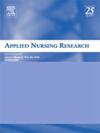Emotion recognition and clinical empathy: An observational study of nurses
IF 2.7
4区 医学
Q1 NURSING
引用次数: 0
Abstract
Aim
To explore nurse ability to recognize emotion and its association with clinical empathy.
Background
Empathy is elemental to nursing care and positively effects patient and nurse outcomes, yet self-reported clinical empathy has declined over the past decade. One hypothesized contributor to the ability of a nurse to be empathic is whether they can recognize emotion, a phenomenon thus far unstudied among nurses.
Methods
This cross-sectional study used online survey methods to collect data from 166 licensed nurses employed in one of 22 hospitals in Florida, USA. The Geneva Emotion Recognition Test-Short Form (GERT-SF) measured behavioral empathy—the ability to identify 7 positive and 7 negative basic emotions from non-language-based audiovisual clips with actors expressing these emotions. The Jefferson Scale of Empathy-Health Professionals measured self-reported clinical empathy in patient care. Demographic and work-related factors were assessed with investigator-designed items. Descriptive and bivariate statistical analyses were employed.
Results
Although nurses self-reported very high clinical empathy, their ability to recognize emotions using the GERT-S tool was fair. Emotion recognition and clinical empathy were weakly correlated (r = 0.175, p = 0.024, 95 % CI = 0.02–0.32). The least recognized emotion for the participants to identify was anxiety. No demographic variables were associated with either emotion recognition or clinical empathy.
Conclusions
These findings expose how nurse perceptions of being empathic may poorly align with the ability to recognize a patient's emotional response. Thus, findings have implications for teaching empathy, as well as for how researchers validly and reliably measure these constructs.
情绪识别与临床移情:护士观察研究
目的探讨护士识别情绪的能力及其与临床移情的关系。背景移情是护理工作的基本要素,对患者和护士的治疗效果有积极影响,但在过去十年中,自我报告的临床移情率有所下降。本横断面研究采用在线调查的方法,收集了美国佛罗里达州 22 家医院中 166 名持证护士的数据。日内瓦情绪识别测验简表(GERT-SF)测量的是行为移情能力,即从演员表达的非语言视听片段中识别 7 种积极和 7 种消极基本情绪的能力。杰斐逊移情量表--卫生专业人员 "测量的是自我报告的在病人护理过程中的临床移情能力。调查人员设计的项目对人口统计学和工作相关因素进行了评估。结果虽然护士自我报告的临床同理心很高,但他们使用 GERT-S 工具识别情绪的能力一般。情绪识别和临床移情呈弱相关(r = 0.175,p = 0.024,95 % CI = 0.02-0.32)。参与者最不容易识别的情绪是焦虑。这些研究结果揭示了护士对共情性的认知与识别患者情绪反应的能力之间的关系。因此,研究结果对移情教学以及研究人员如何有效、可靠地测量这些建构具有重要意义。
本文章由计算机程序翻译,如有差异,请以英文原文为准。
求助全文
约1分钟内获得全文
求助全文
来源期刊

Applied Nursing Research
医学-护理
CiteScore
4.50
自引率
0.00%
发文量
65
审稿时长
70 days
期刊介绍:
Applied Nursing Research presents original, peer-reviewed research findings clearly and directly for clinical applications in all nursing specialties. Regular features include "Ask the Experts," research briefs, clinical methods, book reviews, news and announcements, and an editorial section. Applied Nursing Research covers such areas as pain management, patient education, discharge planning, nursing diagnosis, job stress in nursing, nursing influence on length of hospital stay, and nurse/physician collaboration.
 求助内容:
求助内容: 应助结果提醒方式:
应助结果提醒方式:


